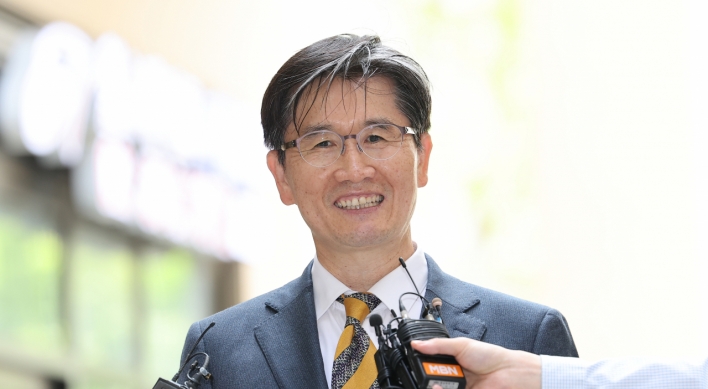A place for time-honored knotty traditions
Experience the colorful history of Korean knots
By Korea HeraldPublished : Jan. 8, 2013 - 19:29
Following is part of a series exploring unique museums, collections and the passionate collectors behind them. ― Ed.
Traditional Korean knots, also known as maedeup, are handmade decorative hanging knot and thread pieces, made using intricate threading techniques that date back as far as the Silla Kingdom (668-935).
The use of these traditional knots was limited to the members of the royal family, but later spread among commoners. Knots in Korea have historically had the usual practical uses such as making tools and as belts for tying garments, but as time passed, these knots slowly became appreciated for their colors and artistic beauty.
Traditional Korean knots, also known as maedeup, are handmade decorative hanging knot and thread pieces, made using intricate threading techniques that date back as far as the Silla Kingdom (668-935).
The use of these traditional knots was limited to the members of the royal family, but later spread among commoners. Knots in Korea have historically had the usual practical uses such as making tools and as belts for tying garments, but as time passed, these knots slowly became appreciated for their colors and artistic beauty.

“It wasn’t until the Joseon Dynasty that knots were used for decoration,” said Park Jin-young, manager of the Donglim Knot Workshop in Gahoe-dong, Seoul.
Since then, maedeup has been used as a fashion statement for clothing as well as for decorative purposes for household items, musical instruments, fans and more. “Now, they are more recognized for their technique and beauty,” she said.
Housed in a quaint hanok, a traditional Korean building, the Donglim Knot Workshop upholds the cultural integrity of time-honored maedeup techniques. When the workshop, formerly the Donglim Knot Museum, first opened its doors in 2004, it originally functioned as a gallery displaying various types of traditional Korean maedeup. However, the former museum has now been converted into a maedeup workshop.
“The reason we decided to add the workshop component to our museum is because we wanted to give our visitors an opportunity to learn how to create these knots,” said Park.

Korean knots are made by laying down a long piece of thick string and shaping it into one’s desired motif. While placing one’s fingers around the piece to maintain its structural form, one end of the string is continuously weaved over and under, creating a tight pattern. These knots come in all different shapes and motifs such as butterfly, lotus and dragonfly patterns.
The art of Korean knots is often characterized by their three-part union of chords, knots and tassels. The chord pieces, which hold the knot together, are made up of braided strands of thread, while the centerpiece ― the knot ― is stranded in a variety of geometrical patterns. The center typically has a decorative medallion or pendant piece woven in between two knot pieces. The last part of a maedeup piece is the tassels, which are bound at the top and hang freely from the knot. Even the tassels come in a variety of styles such as octopus-shaped, braided, and strawberry tassels.
“The key to Korean knots it that the knot pattern must look exactly the same front and back,” she said. “It’s complex in that the knots are made using only one piece of thread so both ends must match up.”
The workshop still exhibits its collection of traditional knot pieces such as ones used for belts, pouches, clothing accessories and simple decorative knots. The pieces on display show a wide variety of different shapes and intricate knot patterns in a beautiful array of bright colors.
The Donglim Knot Workshop is a family-run business that dates back four generations. The founder of the workshop, Shim Young-mi, is considered an expert in the field of Korean knot techniques. The techniques of Korean traditional knots were taught to her by her father-in-law, who learned these techniques from his great aunt, who served as a palace knot technician in the Joseon Dynasty. Shim is now passing on her knowledge of knot-making to her daughter-in-law.
“These techniques have been passed on in my family from generation to generation and these techniques are now being taught to me by my mother-in-law so that we can keep this tradition alive,” Park said.
■ Donglim Knot Workshop (02-3673-2778)
● Location: 11-7 Gahoe-dong, Jongno-gu, Seoul
● Hours: Open Tuesday through Sunday from 10 a.m. to 6 p.m.
● Admission: 2,000 won for adults and 1,000 won for children. Lessons are available in a one-day program as well as in a long-term program for which classes meet once a week for four weeks. Visitors who wish to participate in the knot making classes must call and schedule ahead of time.
For more information, visit http://www.shimyoungmi.com
By Julie Jackson (juliejackson@heraldcorp.com)
-
Articles by Korea Herald










![[Weekender] How DDP emerged as an icon of Seoul](http://res.heraldm.com/phpwas/restmb_idxmake.php?idx=644&simg=/content/image/2024/04/25/20240425050915_0.jpg&u=)

![[Today’s K-pop] NewJeans' single teasers release amid intrigue](http://res.heraldm.com/phpwas/restmb_idxmake.php?idx=644&simg=/content/image/2024/04/26/20240426050575_0.jpg&u=)






![[Herald Interview] Mistakes turn into blessings in street performance, director says](http://res.heraldm.com/phpwas/restmb_idxmake.php?idx=652&simg=/content/image/2024/04/28/20240428050150_0.jpg&u=)
